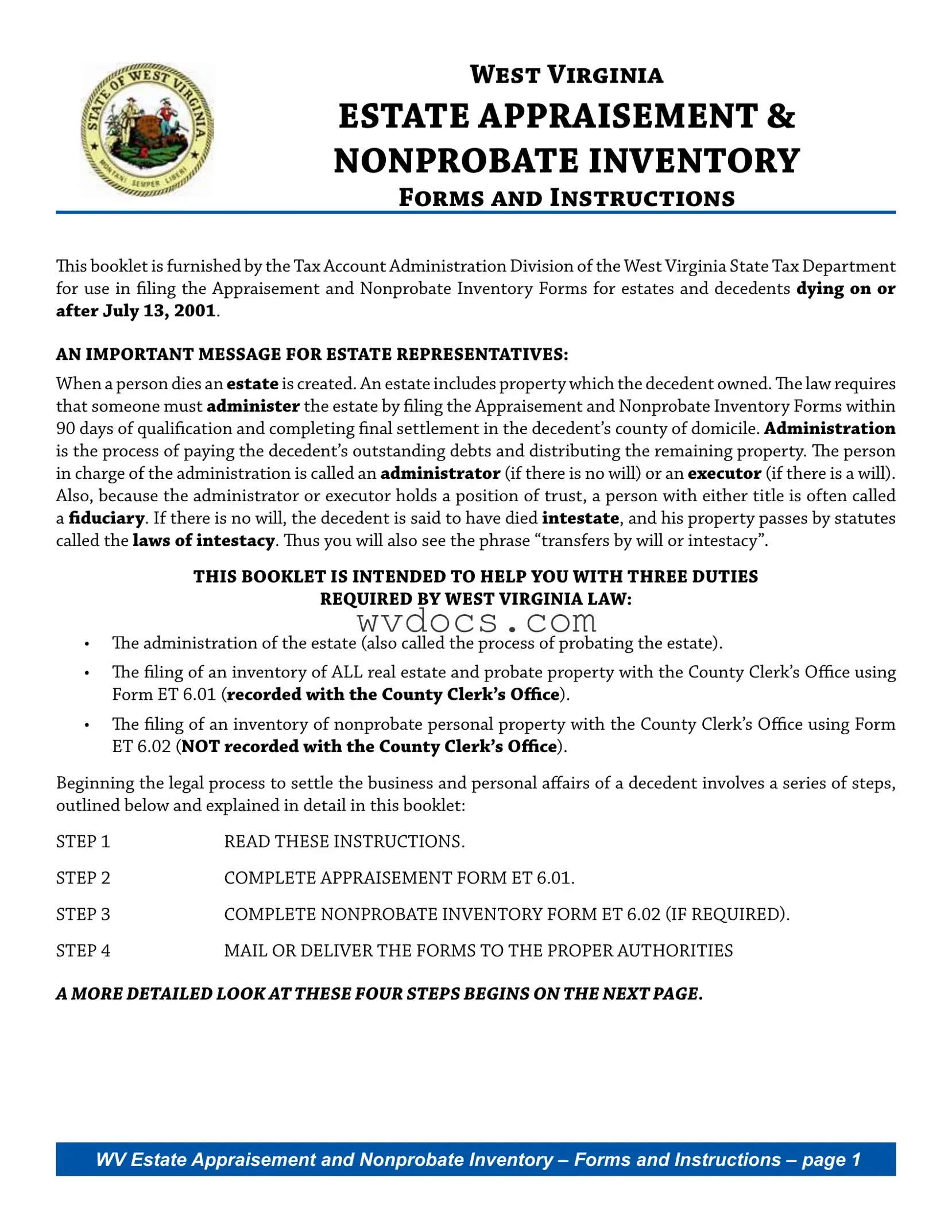The West Virginia Estate form shares similarities with the Federal Estate Tax Return (Form 706). Both documents require the fiduciary to report the decedent's assets and liabilities, ensuring that all relevant financial information is disclosed. The Federal form is specifically designed for estates exceeding a certain value threshold, while the West Virginia form focuses on local estate administration. Both forms also necessitate the valuation of assets at the time of death, which is crucial for tax calculations and distribution purposes.
Another related document is the Inventory of Assets in Probate Estates. This inventory serves to list all probate assets, including real and personal property, just like the West Virginia Estate form. It provides a comprehensive overview of what the decedent owned at the time of death. The key difference lies in the jurisdiction; while the West Virginia form is state-specific, the inventory may be used in various jurisdictions to ensure proper asset management and distribution under probate law.
The Non-Probate Property Inventory is similar to the West Virginia Estate form in that it focuses on assets that do not pass through probate. Both documents require fiduciaries to detail non-probate assets, such as joint accounts and life insurance policies. This distinction is important for understanding the full scope of the decedent's estate, as non-probate assets can bypass the probate process entirely, affecting how debts and distributions are handled.
The Affidavit of Heirship is another document that often accompanies estate forms. It serves to establish the rightful heirs of a decedent's estate, similar to how the West Virginia Estate form identifies beneficiaries. While the West Virginia form is used for formal probate processes, the Affidavit can be used in cases where probate is not necessary, providing a quicker means to transfer assets to heirs based on established relationships.
The Last Will and Testament is intrinsically linked to the West Virginia Estate form, especially when the decedent has left a will. Both documents work in tandem to ensure that the decedent's wishes regarding asset distribution are honored. The estate form helps to execute the will and manage the estate's affairs, while the will itself outlines the decedent's intentions regarding their property and beneficiaries.
The Small Estate Affidavit is another similar document that allows for a simplified process in transferring assets when the estate's value falls below a certain threshold. Like the West Virginia Estate form, it requires the identification of assets and beneficiaries. However, the Small Estate Affidavit can expedite the process significantly, allowing heirs to access property without undergoing full probate proceedings.
The Declaration of Trust is comparable in that it outlines how assets are to be managed and distributed, similar to the instructions provided in the West Virginia Estate form. While the estate form deals with the administration of a decedent's estate, a Declaration of Trust can govern how trust assets are handled during the decedent's life and after their passing, providing a clear framework for asset management.
When navigating the complexities of boat ownership transfers in California, it is vital to utilize the appropriate documentation, such as the California Boat Bill of Sale form. This form not only legitimizes the sale but also aids in the registration process under the new owner's name. To ensure a smooth transaction, you can find valuable resources and templates at onlinelawdocs.com, providing clear guidance on completing this essential document effectively.
The Power of Attorney document is relevant in estate planning and shares similarities with the West Virginia Estate form in terms of authority and asset management. Both documents empower individuals to make decisions regarding assets, though the Power of Attorney typically becomes ineffective upon death, while the estate form is activated upon the decedent's passing, guiding the fiduciary in managing the estate.
The Certificate of Death is a critical document that serves as the foundation for initiating the estate process, including the West Virginia Estate form. It verifies the decedent's passing and provides essential information such as the date of death, which is vital for determining asset valuations and the timeline for filing estate-related documents.
Lastly, the Petition for Probate is closely related to the West Virginia Estate form as it initiates the probate process. This petition must be filed with the court to formally open the estate, allowing the fiduciary to begin the administration process. Both documents require detailed information about the decedent and their assets, ensuring a smooth transition into the probate phase.






 Attorney
Attorney 




 Attorney
Attorney 